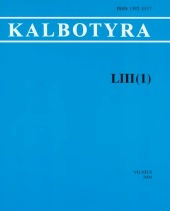Morfologinių lietuvių, norvegų ir suomių kalbų kauzatyvų sintaksė
The syntax of morphological causatives in Lithuanian, Norwegian and Finnish.
Author(s): Sigita RackevičienėSubject(s): Language and Literature Studies, Semiotics / Semiology, Syntax, Semantics, Comparative Linguistics, Finno-Ugrian studies, Baltic Languages
Published by: Vilniaus Universiteto Leidykla
Keywords: morphological causative; Norwegian language; Finnish language; causator; subject;
Summary/Abstract: The article aims at analyzing the syntactic structures, formed by morphological causatives (causative verbs) in Lithuanian, Norwegian and Finnish languages. The performed analysis allows for drawing the following conclusions: 1) Morphological causatives form syntactic opposites of two types with non-causatives of the corresponding meaning: (a) syntactic oppositions, in which the causative has one satellite more than the non-causative of the corresponding meaning and (b) syntactic oppositions, in which the causative has the same number of satellites as the non-causative of the corresponding meaning. 2) In all the three languages under study the absolute majority of morphological causatives participate in syntactic opposites of type (a). In those opposites the causative takes over the satellites of the corresponding non-causative and subordinates one new satellite, i. e. the causator, which occupies the syntactic position of the subject, e. g. “Sniegas tirpsta – Saulė tirpdo sniegą” (“The snow melts – the Sun is melting the snow”). The syntactic positions of the satellites, taken over from the non-causative in a causative environment depend on the semantics of the causative. 3) In the syntactic oppositions of type (b) there are morphological causatives, expressing causation of a psychic/psychic-physical state. They take over the satellites of the non-causative and do not subordinate any new satellites. The syntactic position of the subject is most frequently taken by the non-causative satellite, performing the role of the cause for the state, e. g. “Aš pykstu dėl tavo elgesio -- Tavo elgesys mane pykdo” (“I’m upset at your behaviour – You behaviour upsets me”). Such constructions are found in Lithuanian and Finnish languages, since in Norwegian there are no morphological causatives, expressing the causation of a psychic/psychic-physical state.
Journal: Kalbotyra
- Issue Year: 2004
- Issue No: 53
- Page Range: 47-58
- Page Count: 12
- Language: Lithuanian

